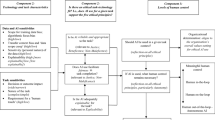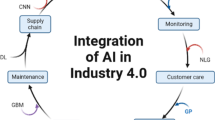Abstract
This paper reports on an experimental study on human–machine interface in LED manufacturing systems to measure the influence of information overload on user experience. The results are based on cognitive ergonomics. The experiment used eye-tracking methods and a questionnaire to gather data. The independent variables were interface complexity and user background. Interface complexity had three levels: high interface complexity, moderate interface complexity and low interface complexity. User background had two levels: the novice group and the expert group. The dependent variables included time to first fixation, fixations before and subjective feelings. A total of 38 operators participated in the experiment, and the results showed that (1) interface complexity caused a significant difference in time to first fixation (P < 0.05) and fixations before (P < 0.05). Furthermore, the results revealed significant differences between high complexity interfaces compared to low complexity interfaces (P < 0.05). However, no significant differences were observed between moderate and low complexity interfaces or between moderate and high complexity interfaces (P > 0.05); (2) user background significantly affected the user experience; (3) within the same complexity level, expert operators’ cognitive workload was significantly lower than that of novice operators; and (4) there was no significant relationship between the interface complexity and the user’s background. The study concludes that because interface complexity has a significant effect on the time taken to locate the target button on the screen, interface design should be as simple as possible, while still providing the necessary level of functionality.








Similar content being viewed by others

References
Augustyniak P, Tadeusiewicz R (2006) Assessment of electrocardiogram visual interpretation strategy based on scanpath analysis. Physiol Meas 27(7):597–608. doi:10.1088/0967-3334/27/7/004
Bargas-Avila JA, Hornbæk K (2011) Old wine in new bottles or novel challenges: a critical analysis of empirical studies of user experience. In: Proceedings of the SIGCHI conference on human factors in computing systems, 2011. ACM, pp 2689–2698
Burch M, Heinrich J, Konevtsova N, Hoferlin M, Weiskopf D (2011) Evaluation of traditional, orthogonal, and radial tree diagrams by an eye tracking study. IEEE Trans Vis Comput Graph 17(12):2440–2448
Chen L, Pu P (2014) Experiments on user experiences with recommender interfaces. Behav Inf Technol 33(4):372–394. doi:10.1080/0144929x.2012.719034
Chevalier A, Maury AC, Fouquereau N (2014) The influence of the search complexity and the familiarity with the website on the subjective appraisal of aesthetics, mental effort and usability. Behav Inf Technol 33(2):116–131. doi:10.1080/0144929x.2013.819936
Desmet P, Hekkert P (2007) Framework of product experience. Int J Des 1(1):57–66
Duchowski AT (2002) A breadth-first survey of eye-tracking applications. Behav Res Methods Instrum Comput 34(4):455–470. doi:10.3758/Bf03195475
Goldberg J, Helfman J (2011) Eye tracking for visualization evaluation: reading values on linear versus radial graphs. Inf Vis 10(3):182–195. doi:10.1177/1473871611406623
Goldberg JH, Kotval XP (1999) Computer interface evaluation using eye movements: methods and constructs. Int J Ind Ergon 24(6):631–645. doi:10.1016/S0169-8141(98)00068-7
Hornbaek K (2006) Current practice in measuring usability: challenges to usability studies and research. Int J Hum Comput Stud 64(2):79–102. doi:10.1016/j.ijhcs.2005.06.002
ISO W (1998) 9241-11. Ergonomic requirements for office work with visual display terminals (VDTs). The international organization for standardization, London
Ito K, Speer SR (2008) Anticipatory effects of intonation: eye movements during instructed visual search. J Mem Lang 58(2):541–573. doi:10.1016/j.jml.2007.06.013
Liu P, Li Z (2012) Task complexity: a review and conceptualization framework. Int J Ind Ergon 42(6):553–568
Liu HC, Lai ML, Chuang HH (2011) Using eye-tracking technology to investigate the redundant effect of multimedia web pages on viewers’ cognitive processes. Comput Hum Behav 27(6):2410–2417. doi:10.1016/j.chb.2011.06.012
Lu WX, Li M, Lu SF, Song YY, Yin JJ, Zhong N (2011) Visual search strategy and information processing mode: an eye-tracking study on web pages under information overload. Commun Comput Inf Sci 86:153–159
Maldonado A, Garca JL, Alvarado A, Balderrama CO (2013) A hierarchical fuzzy axiomatic design methodology for ergonomic compatibility evaluation of advanced manufacturing technology. Int J Adv Manuf Technol 66(1–4):171–186. doi:10.1007/s00170-012-4316-8
Nielsen J (1994) Usability engineering. Elsevier, Amsterdam
Norman DA (2002) The design of everyday things. Basic books, New York
Norman DA (2004) Emotional design: why we love (or hate) everyday things. Basic books, New York
Oborski P (2003) Social-technical aspects in modern manufacturing. Int J Adv Manuf Technol 22(11–12):848–854. doi:10.1007/s00170-003-1573-6
Oborski P (2004) Man-machine interactions in advanced manufacturing systems. Int J Adv Manuf Technol 23(3–4):227–232. doi:10.1007/s00170-003-1574-5
Park J, Han SH, Kim HK, Oh S, Moon H (2013) Modeling user experience: a case study on a mobile device. Int J Ind Ergon 43(2):187–196. doi:10.1016/j.ergon.2013.01.005
Pernice K, Nielsen J (2009) Eyetracking methodology: how to conduct and evaluate usability studies using eyetracking. Nielsen Norman Group Technical Report
Ramakrisnan P, Jaafar A, Razak FHA, Ramba DA (2012) Evaluation of user interface design for leaning management system (LMS): investigating student’s eye tracking pattern and experiences. Procedia Soc Behav Sci 67:527–537. doi:10.1016/j.sbspro.2012.11.357
Roth SP, Tuch AN, Mekler ED, Bargas-Avila JA, Opwis K (2013) Location matters, especially for non-salient features—An eye-tracking study on the effects of web object placement on different types of websites. Int J Hum Comput Stud 71(3):228–235. doi:10.1016/j.ijhcs.2012.09.001
Roto V, Vermeeren A, Väänänen-Vainio-Mattila K, Law E (2011) User experience evaluation—which method to choose? In: Human–computer interaction—INTERACT 2011. Springer, pp 714–715
Rubio S, Diaz E, Martin J, Puente JM (2004) Evaluation of subjective mental workload: a comparison of SWAT, NASA-TLX, and workload profile methods. Appl Psychol Int Rev 53(1):61–86. doi:10.1111/j.1464-0597.2004.00161.x
Savioja P, Liinasuo M, Koskinen H (2014) User experience: does it matter in complex systems? Cognit Technol Work 16(4):429–449
Seffah A, Donyaee M, Kline RB, Padda HK (2006) Usability measurement and metrics: a consolidated model. Softw Qual J 14(2):159–178. doi:10.1007/s11219-006-7600-8
Shackel B (1991) Usability-context, framework, definition, design and evaluation. Human factors for informatics usability. Cambridge University Press, Cambridge, pp 21–34
Shin DH, Biocca F, Choo H (2013) Exploring the user experience of three-dimensional virtual learning environments. Behav Inf Technol 32(2):203–214. doi:10.1080/0144929x.2011.606334
Spiekermann S, Korunovska J (2014) The importance of interface complexity and entropy for online information sharing. Behav Inf Technol 33(6):636–645. doi:10.1080/0144929x.2013.845910
Stickel C, Ebner M, Holzinger A (2010) The XAOS metric—understanding visual complexity as measure of usability. Lect Notes Comput Sci 6389:278–290
Tuch AN, Bargas-Avila JA, Opwis K, Wilhelm FH (2009) Visual complexity of websites: effects on users’ experience, physiology, performance, and memory. Int J Hum Comput Stud 67(9):703–715. doi:10.1016/j.ijhcs.2009.04.002
Tuch AN, Kreibig SD, Roth SP, Bargas-Avila JA, Opwis K, Wilhelm FH (2011) The role of visual complexity in affective reactions to webpages: subjective, eye movement, and cardiovascular responses. IEEE Trans Affect Comput 2(4):230–236. doi:10.1109/Taff-C.2011.18
Tuch AN, Presslaber EE, Stocklin M, Opwis K, Bargas-Avila JA (2012) The role of visual complexity and prototypicality regarding first impression of websites: working towards understanding aesthetic judgments. Int J Hum Comput Stud 70(11):794–811. doi:10.1016/j.ijhcs.2012.06.003
Veneri G, Pretegiani E, Rosini F, Federighi P, Federico A, Rufa A (2012) Evaluating the human ongoing visual search performance by eye tracking application and sequencing tests. Comput Methods Prog Biomed 107(3):468–477. doi:10.1016/j.cmpb.2011.02.006
Vermeeren AP, Law EL-C, Roto V, Obrist M, Hoonhout J, Väänänen-Vainio-Mattila K (2010) User experience evaluation methods: current state and development needs. In: Proceedings of the 6th Nordic conference on human–computer interaction: extending boundaries, 2010. ACM, pp 521–530
Yockey HP (2002) Information theory, evolution and the origin of life. Inf Sci 141(3–4):219–225. doi:10.1016/S0020-0255(02)00173-1
Zhang ZF (2012) Manufacturing complexity and its measurement based on entropy models. Int J Adv Manuf Technol 62(9–12):867–873. doi:10.1007/s00170-011-3872-7
Zulch G, Stowasser S (2003) Eye tracking for evaluating industrial human–computer interfaces. In: Mind’s eye: cognitive and applied aspects of eye movement research, pp 531–553. doi:10.1016/B978-044451020-4/50029-3
Acknowledgments
We thank our reviewers for their valuable and insightful comments. This paper is financially supported by the Fundamental Research Funds for the Central Universities HUST: (2014QN017). Also, we thank King Far International Inc. for assistance with the research device.
Author information
Authors and Affiliations
Corresponding author
Rights and permissions
About this article
Cite this article
Wu, L., Zhu, Z., Cao, H. et al. Influence of information overload on operator’s user experience of human–machine interface in LED manufacturing systems. Cogn Tech Work 18, 161–173 (2016). https://doi.org/10.1007/s10111-015-0352-0
Received:
Accepted:
Published:
Issue Date:
DOI: https://doi.org/10.1007/s10111-015-0352-0



